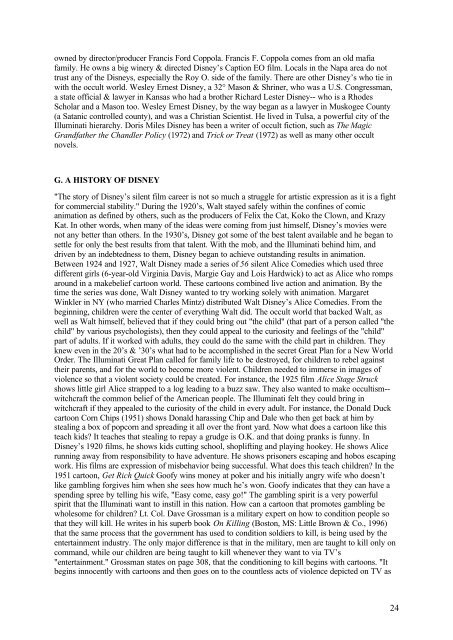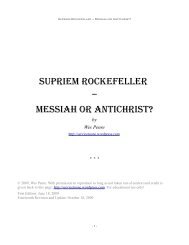Bloodlines of Illuminati
Bloodlines of The Illuminati - S pirit S elf
Bloodlines of The Illuminati - S pirit S elf
- No tags were found...
Create successful ePaper yourself
Turn your PDF publications into a flip-book with our unique Google optimized e-Paper software.
owned by director/producer Francis Ford Coppola. Francis F. Coppola comes from an old mafia<br />
family. He owns a big winery & directed Disney’s Caption EO film. Locals in the Napa area do not<br />
trust any <strong>of</strong> the Disneys, especially the Roy O. side <strong>of</strong> the family. There are other Disney’s who tie in<br />
with the occult world. Wesley Ernest Disney, a 32° Mason & Shriner, who was a U.S. Congressman,<br />
a state <strong>of</strong>ficial & lawyer in Kansas who had a brother Richard Lester Disney-- who is a Rhodes<br />
Scholar and a Mason too. Wesley Ernest Disney, by the way began as a lawyer in Muskogee County<br />
(a Satanic controlled county), and was a Christian Scientist. He lived in Tulsa, a powerful city <strong>of</strong> the<br />
<strong>Illuminati</strong> hierarchy. Doris Miles Disney has been a writer <strong>of</strong> occult fiction, such as The Magic<br />
Grandfather the Chandler Policy (1972) and Trick or Treat (1972) as well as many other occult<br />
novels.<br />
G. A HISTORY OF DISNEY<br />
"The story <strong>of</strong> Disney’s silent film career is not so much a struggle for artistic expression as it is a fight<br />
for commercial stability." During the 1920’s, Walt stayed safely within the confines <strong>of</strong> comic<br />
animation as defined by others, such as the producers <strong>of</strong> Felix the Cat, Koko the Clown, and Krazy<br />
Kat. In other words, when many <strong>of</strong> the ideas were coming from just himself, Disney’s movies were<br />
not any better than others. In the 1930’s, Disney got some <strong>of</strong> the best talent available and he began to<br />
settle for only the best results from that talent. With the mob, and the <strong>Illuminati</strong> behind him, and<br />
driven by an indebtedness to them, Disney began to achieve outstanding results in animation.<br />
Between 1924 and 1927, Walt Disney made a series <strong>of</strong> 56 silent Alice Comedies which used three<br />
different girls (6-year-old Virginia Davis, Margie Gay and Lois Hardwick) to act as Alice who romps<br />
around in a makebelief cartoon world. These cartoons combined live action and animation. By the<br />
time the series was done, Walt Disney wanted to try working solely with animation. Margaret<br />
Winkler in NY (who married Charles Mintz) distributed Walt Disney’s Alice Comedies. From the<br />
beginning, children were the center <strong>of</strong> everything Walt did. The occult world that backed Walt, as<br />
well as Walt himself, believed that if they could bring out "the child" (that part <strong>of</strong> a person called "the<br />
child" by various psychologists), then they could appeal to the curiosity and feelings <strong>of</strong> the "child"<br />
part <strong>of</strong> adults. If it worked with adults, they could do the same with the child part in children. They<br />
knew even in the 20’s & ’30’s what had to be accomplished in the secret Great Plan for a New World<br />
Order. The <strong>Illuminati</strong> Great Plan called for family life to be destroyed, for children to rebel against<br />
their parents, and for the world to become more violent. Children needed to immerse in images <strong>of</strong><br />
violence so that a violent society could be created. For instance, the 1925 film Alice Stage Struck<br />
shows little girl Alice strapped to a log leading to a buzz saw. They also wanted to make occultism--<br />
witchcraft the common belief <strong>of</strong> the American people. The <strong>Illuminati</strong> felt they could bring in<br />
witchcraft if they appealed to the curiosity <strong>of</strong> the child in every adult. For instance, the Donald Duck<br />
cartoon Corn Chips (1951) shows Donald harassing Chip and Dale who then get back at him by<br />
stealing a box <strong>of</strong> popcorn and spreading it all over the front yard. Now what does a cartoon like this<br />
teach kids? It teaches that stealing to repay a grudge is O.K. and that doing pranks is funny. In<br />
Disney’s 1920 films, he shows kids cutting school, shoplifting and playing hookey. He shows Alice<br />
running away from responsibility to have adventure. He shows prisoners escaping and hobos escaping<br />
work. His films are expression <strong>of</strong> misbehavior being successful. What does this teach children? In the<br />
1951 cartoon, Get Rich Quick Go<strong>of</strong>y wins money at poker and his initially angry wife who doesn’t<br />
like gambling forgives him when she sees how much he’s won. Go<strong>of</strong>y indicates that they can have a<br />
spending spree by telling his wife, "Easy come, easy go!" The gambling spirit is a very powerful<br />
spirit that the <strong>Illuminati</strong> want to instill in this nation. How can a cartoon that promotes gambling be<br />
wholesome for children? Lt. Col. Dave Grossman is a military expert on how to condition people so<br />
that they will kill. He writes in his superb book On Killing (Boston, MS: Little Brown & Co., 1996)<br />
that the same process that the government has used to condition soldiers to kill, is being used by the<br />
entertainment industry. The only major difference is that in the military, men are taught to kill only on<br />
command, while our children are being taught to kill whenever they want to via TV’s<br />
"entertainment." Grossman states on page 308, that the conditioning to kill begins with cartoons. "It<br />
begins innocently with cartoons and then goes on to the countless acts <strong>of</strong> violence depicted on TV as<br />
24




